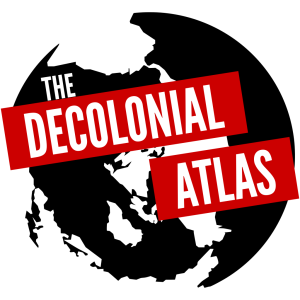Here at the Decolonial Atlas, we’ve been working to challenge imperial narratives wherever they exist in cartography. Recently though, we’ve heard from our community that the Atlas has not presented enough material about non-Western imperialism. Addressing that, we decided to attempt a decolonized map of བོད་ (Bö, commonly known as Tibet in the West), labelled in བོད་སྐད་ (Böké, the Tibetan language), and acknowledging Bö as a distinct territory from China which has occupied the country since 1950. Under Chinese occupation, Bö has been wiped off the map, divided up, renamed, and incorporated into Chinese provinces. By creating a map that subverts those efforts, we can more easily visualize a free and independent Bö.
In this map, the area in white represents “Ethnic Tibet,” the region where the བོད་པ་ (Böpa, Tibetan people) have historically predominated, as opposed to the smaller བོད་རང་སྐྱོང་ལྗོངས། (Börang Kyongjong, Tibet Autonomous Region) or “Political Tibet,” a modern jurisdiction of China. If Bö achieved independence, it would be the world’s tenth largest country by area. Traditionally, Bö has three main regions: ཨ༌མདོ (Amdo), ཁམས་ (Kham), and དབུས་གཙང་ (Ü-Tsang). The latter forms the bulk of Börang Kyongjong, and has historically been independently ruled from its capital, ལྷ་ས་ (Lhasa, literally ‘Place of gods’). Amdo and Kham, being further east and in closer proximity to China than Lhasa, have historically achieved less autonomy despite persistent resistance. Following the 1959 Tibetan Uprising in which some 87,000 Böpa died revolting against Chinese occupation, the Dalai Lama and others fled across the border to establish the བོད་མིའི་སྒྲིག་འཛུགས་ (Bömi Drikdzuk, Tibetan Government in Exile) in རྡ་རམ་ས་ལ། (Dharamshala India), where they have continued to fight for the Böpa for the past 60 years.
The word ‘Tibet’ made its way into English in the 18th century from Turkic-speaking peoples in Western and Central Asia who called this region Töbäd (Literally ‘The heights’). Indeed, Bö is often called ‘the roof of the world.’ The world’s highest mountain, ཇོ་མོ་གླང་མ (Chomolungma, Mount Everest), and the ཧི་མ་ལ་ཡ (Himalayas) form Bö’s southern frontier. Supplying water to billions of people, many of Asia’s great rivers find their source in Bö, including the ཡར་ཀླུང་གཙང་པོ་ (Yarlung Tsangpo, Brahmaputra), གླང་ཆེན་ཁ་བབས། (Langchen Khabab, Ganges), སེང་གེ་ཁ་འབབ (Sengé Khabab, Indus), ཟླ་ཆུ། (Dachu, Mekong), རྒྱལ་མོ་རྔུལ་ཆུ། (Gyalmo Ngulchu, Salween), འབྲི་ཆུ (Drichu ‘river of the female yak’, Yangtze), and རྨ་ཆུ། (Machu ‘river of the peacock’, Yellow).

བོད་ (Bö, Tibet) in བོད་སྐད་ (Böké, Tibetan) by Jordan Engel.

བོད་ (Bö, Tibet) in བོད་སྐད་ (Böké, Tibetan) and English by Jordan Engel.
Traditional regions of བོད་ (Bö, Tibet), from Wikipedia.
These maps, except for the last one, were made by Jordan Engel. They can be reused under the Decolonial Media License 0.1.
Sources:
Wikipedia Historic Tibet Map
Wikipedia Tibet Provinces Map


[…] via Tibet Decolonized — The Decolonial Atlas […]
LikeLike
it’s Bö, not Bod, Bod is classical Tibetan and is only used in Wylie transliteration which only transliterates the written script and it’s not how you pronounce it.
Bod = Bö
Bod Skad = Böké
Bod Pa = Böpa
Bod Rang Skyong Ljongs = Börang Kyongjong
Bod Mi’i Sgrig ‘Dzugs = Bömi Drikdzuk
Yar Klung Gtsang Po = Yarlung Tsangpo
Glang Chen Kha Babs = Langchen Khabab
Seng Ge Kha ‘Bab = Sengé Khabab
Zla Chu = Dachu
Rgyal Mo Rngul Chu = Gyalmo Ngulchu
Bri Chu= Drichu
Rma Chu = Machu
ཁྲིན་ཀོན་ཆུས། is not the Tibetan name of Lhasa (that’s ལྷ་ས་) but instead that’s the Tibetan name for Chengguan which is a district in Lhasa
LikeLike